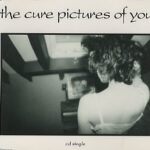 The Cure’s “Pictures of You,” released in 1989 as part of their landmark album Disintegration, is a masterclass in emotional storytelling through music. At its core, the song captures the aching nostalgia and bittersweet longing that accompanies lost love, memory, and reflection. With its lush instrumentation, ethereal production, and Robert Smith’s evocative vocals, “Pictures of You” transcends the boundaries of gothic rock to create a universally relatable exploration of grief, regret, and the fragile beauty of human connection. Over three decades after its release, the song remains a cornerstone of The Cure’s catalog and a defining moment in alternative music.
The Cure’s “Pictures of You,” released in 1989 as part of their landmark album Disintegration, is a masterclass in emotional storytelling through music. At its core, the song captures the aching nostalgia and bittersweet longing that accompanies lost love, memory, and reflection. With its lush instrumentation, ethereal production, and Robert Smith’s evocative vocals, “Pictures of You” transcends the boundaries of gothic rock to create a universally relatable exploration of grief, regret, and the fragile beauty of human connection. Over three decades after its release, the song remains a cornerstone of The Cure’s catalog and a defining moment in alternative music.
From the opening notes, “Pictures of You” establishes an atmosphere of melancholy and contemplation. The intro features chiming guitar arpeggios, reverberating keyboards, and a gently undulating bassline. The textures are layered yet delicate, setting a reflective tone that invites the listener into a personal space. There is a cinematic quality to the arrangement: the song feels expansive, as though it occupies both a physical and emotional landscape. This sonic space mirrors the emotional content of the lyrics — a world caught between the tangible and the intangible, memory and reality, presence and absence.
Lyrical Mastery and Emotional Resonance
The lyrics of “Pictures of You” are deeply introspective and vividly visual. Robert Smith paints images that are simultaneously specific and universal, allowing listeners to project their own experiences onto the song. Lines such as “I’ve been looking so long at these pictures of you / That I almost believe that they’re real” convey the interplay between memory and longing. The act of gazing at photographs becomes a metaphor for revisiting the past, confronting loss, and clinging to fragments of what once was.
What makes the lyricism remarkable is its precision and restraint. Smith avoids overly florid language, instead opting for plainspoken phrases that carry immense emotional weight. Each word is carefully chosen, emphasizing the authenticity of feeling rather than decorative poetry. The song’s narrative is less about chronological events and more about emotional landscapes — the ache of absence, the tension between remembrance and reality, and the lingering presence of someone no longer near.
The recurring motif of photographs amplifies the sense of nostalgia and introspection. Pictures, frozen in time, serve as both a comfort and a source of pain. They preserve moments but also emphasize the passage of time, making the song an exploration of memory’s power to evoke both joy and sorrow. This duality gives “Pictures of You” its profound emotional complexity.
Vocal Performance: Fragility and Intensity
Robert Smith’s vocal delivery is central to the song’s impact. His voice is at once fragile and commanding, capable of conveying both vulnerability and emotional intensity. In the verses, his tone is intimate and almost confessional, drawing the listener into the emotional core of the song. During the choruses, he amplifies the emotional weight, soaring over the dense instrumentation with a mix of pain, longing, and cathartic release.
The subtle quiver in Smith’s voice during key lines conveys the rawness of grief and nostalgia. It’s a vocal performance that doesn’t rely on technical virtuosity but on emotional honesty. The sense of authenticity makes the listener feel as though they are eavesdropping on a private moment of reflection, intensifying the connection between artist and audience.
Moreover, Smith’s phrasing and timing are impeccable. He lingers on certain words, allowing them to resonate, and he navigates the shifts between introspective verses and expansive choruses with fluidity. This dynamic vocal approach ensures that every moment of the song contributes to its overarching emotional arc.
Instrumentation: Layered Atmospheres
The instrumentation on “Pictures of You” is a defining element of its enduring appeal. The song opens with chiming, delay-laden guitars, creating a shimmering, ethereal texture that immediately evokes a sense of space and reflection. This is complemented by keyboard pads that provide an atmospheric backdrop, deepening the sense of emotional immersion.
The rhythm section, consisting of Phil Thornalley’s bass and Boris Williams’ drums, provides a steady yet unobtrusive foundation. The bassline is melodic and fluid, weaving through the harmonic structure, while the drums maintain a restrained, almost hypnotic pulse. The interplay between rhythm and melody reinforces the song’s contemplative mood, allowing the guitars and keyboards to float above without losing cohesion.
As the song progresses, additional layers — including secondary guitar lines, subtle percussion, and harmonized vocals — are gradually introduced. This careful layering creates a sense of buildup without overwhelming the listener, culminating in a chorus that feels emotionally expansive. The production, handled with meticulous care, ensures that every element contributes to the song’s immersive atmosphere.
Themes of Loss and Memory
“Pictures of You” is thematically rich, exploring the interplay between loss, memory, and emotional reconstruction. The song captures the universal experience of looking back on a relationship, confronting both the beauty and pain of what has passed. The act of remembrance is depicted as simultaneously comforting and haunting, a paradox that resonates deeply with listeners.
The song also touches on themes of impermanence and the passage of time. The photographs serve as a metaphor for memory itself — static images that preserve fleeting moments, highlighting the tension between what once was and what now remains only in recollection. This thematic depth elevates “Pictures of You” beyond a standard love song, transforming it into a meditation on human experience, memory, and the enduring impact of relationships.
Context in The Cure’s Discography
“Pictures of You” occupies a pivotal place in The Cure’s catalog. Disintegration, the album from which it originates, represents a mature, fully realized vision of the band’s sound: a blend of gothic sensibility, atmospheric rock, and emotionally raw songwriting. Within this context, “Pictures of You” stands out for its combination of lush production and lyrical intimacy.
The song also illustrates the band’s evolution from earlier post-punk and gothic work toward a more expansive, emotionally nuanced style. While earlier songs like “A Forest” or “Boys Don’t Cry” showcased mood and narrative in compact forms, “Pictures of You” embraces extended structures, layered instrumentation, and deep emotional resonance. It exemplifies The Cure’s ability to blend introspective lyricism with sonic grandeur.
Emotional Arc and Catharsis
One of the most compelling aspects of “Pictures of You” is its emotional arc. The song begins in a state of quiet reflection, gradually building toward cathartic peaks in the chorus. The combination of soaring vocals, dense instrumentation, and lyrical repetition creates a sense of emotional release, allowing listeners to experience both the weight of memory and the relief of shared feeling.
The bridge section, featuring guitar swells and atmospheric synths, provides a moment of introspective pause before the song’s final, emotionally charged choruses. This structural decision enhances the song’s narrative flow, giving listeners time to absorb and reflect before being swept up again in the emotional crescendo. It mirrors the cyclical nature of memory and grief, alternating between quiet introspection and intense emotional impact.
Production Excellence
The production on “Pictures of You” is a testament to The Cure’s meticulous approach to sound design. Every layer is carefully placed, from the shimmering guitar arpeggios to the atmospheric keyboard textures. The mix allows each element to breathe, creating a sense of space and depth that mirrors the song’s thematic exploration of emotional expansiveness.
Robert Smith’s use of reverb, delay, and layered instrumentation contributes to the song’s dreamlike quality. The production enhances the lyrical themes, turning the act of listening into a fully immersive experience. The sonic landscape is both vast and intimate, reflecting the duality of memory — the private, internal experience set against the expansive, often overwhelming nature of emotional reflection.
Timelessness and Influence
“Pictures of You” has endured not only because of its emotional potency but also because of its musical sophistication. Its blend of atmospheric rock, lyrical depth, and emotive vocal delivery has influenced countless artists in alternative, indie, and electronic music. The song’s themes of nostalgia, memory, and lost love remain universally relevant, ensuring its continued resonance across generations.
Its inclusion in popular culture — from film soundtracks to television dramas — attests to its evocative power. The song can instantly evoke a sense of longing, introspection, or melancholy, demonstrating its ability to communicate emotion in ways that transcend language or era.
Conclusion: A Masterpiece of Emotional Rock
“Pictures of You” exemplifies The Cure at their most emotionally expressive and musically sophisticated. The song blends introspective lyrics, haunting melodies, and lush instrumentation to create an immersive exploration of memory, loss, and the enduring power of human connection. Robert Smith’s vocals convey vulnerability, longing, and cathartic release, while the band’s careful production ensures that every note and texture contributes to the emotional arc.
Beyond its technical and artistic achievements, the song resonates because it speaks to universal human experiences. It captures the ache of nostalgia, the complexity of memory, and the bittersweet beauty of love lost or transformed. Its themes remain as relevant today as they were over thirty years ago, making it not only a cornerstone of The Cure’s catalog but a timeless anthem for listeners navigating the complexities of emotion and memory.
“Pictures of You” is more than a song; it is a meditation on what it means to hold the past in one’s mind and heart, a sonic tapestry of longing and reflection. Its combination of musical artistry, lyrical insight, and emotional resonance ensures that it will remain an enduring masterpiece, captivating listeners for generations to come.


